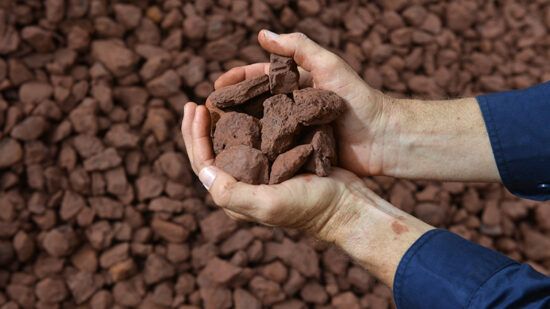When enjoying a chocolate egg this Easter, few consider the origins of its ingredients or the environmental and social impact of its production. The importance of supporting a responsible cocoa production and the oversight role investors can play in ensuring equitable supply chains. That’s why engagement with the cocoa industry to improve its track record is vital
To fully understand the origins of the cocoa bean and the complexities that accompany its journey across the chocolate value chain, we travelled to the Ivory Coast on a field trip led by Switzerland-based Barry Callebaut, one of the world’s largest chocolate producers. The goal of the mission was to gain a first-hand understanding of where the main obstacles to improving the long-term sustainability of the cocoa supply chain lie, and to attest that the industry is taking concrete action to ensure they are addressed.
The cocoa economy of the Ivory Coast: A challenging sector
Nearly half of the world’s cocoa supply is grown in the Ivory Coast. Not only is the economy heavily reliant on cocoa, employing about six million people and accounting for 30% of the value of the country’s exports in 2022, it also plays an integral part of the culture. Yet, many cocoa farmers are barely living at subsistence levels.
External observers and the investment community have voiced concerns about child labour in the cocoa sector since at least 2001 when the Harkin Engel Protocol was adopted to address the use of child labour in the cocoa sector. But poverty has hampered ongoing efforts to tackle the use of child labour in cocoa production. More recently, falling yields, partially due to the loss of shade trees and lower rainfall, as well as the lack of manpower to ensure the proper maintenance of cocoa trees are aggravating the situation for farmers. To complicate matters, the Ivory Coast experienced civil war and political turmoil in the last 20 years. This is compounded by strict government controls on cocoa production, making it difficult to tackle issues such as crop and income diversification.
Cultivating the food of the gods
Cocoa is mostly grown in small plots by independent smallholder farmers. The cacao tree – known as Theobroma cacao, or food of the gods – is notoriously challenging to grow. It takes between five and six years to produce its first fruits and each fruit requires at least five months to be ready for harvest. The plants need a hot and humid climate to thrive, so they should be grown under taller trees or other crops to shelter from the direct sunlight.
Processing the pods is manual and labour intensive and too complex to be automated. Farmers have to open the pods by hand to remove the pulp and separate the beans. Once cleaned of debris, the beans are fermented over banana leaves for about a week, then dried in the sun. After drying, beans are taken to cooperatives for collection and eventually sent to a grinding facility, where they are cleaned, roasted and refined to produce a so-called “liquor”, which is then separated into cocoa butter and cocoa powder. From these two basic ingredients, the factory can then prepare the products for export.
Systemic issues and the path to sustainability
One clear takeaway from the trip to the Ivory Coast is that for cocoa to be sustainable – and for cocoa farmers to earn a living wage while protecting nature and the rights of vulnerable groups – governments, the industry and investors must all work together to drive significant and systematic change.
Improving yields to improve livelihoods. One of the key issues affecting the sector is that the country’s cocoa yields have shrunk over the past two decades, dropping from a peak of 700 kilograms per hectare to 520 kilograms. A recent report by Cocoa Barometer estimates that the amount of cocoa produced per hectare worldwide has slumped to around 350 kilograms per hectare, with the typical farming plot being around three hectares.
Climate change. Contributing to the trend of shrinking yields is the fact that cocoa crops are highly sensitive to the changing climate. The Ivory Coast is experiencing desertification from the north, which coupled with deforestation to clear land for agricultural crops, is reducing the land available to grow cocoa. Without action to improve yields, for example by growing more resistant cocoa varieties, West African producers risk cocoa buyers simply switching suppliers. Ecuador and Brazil, for example, offer the right growing conditions.
Child labour. Child labour has been and continues to be a deep-rooted problem in the global chocolate value chain. In Ivory Coast, the practice is illegal and is officially discouraged. Poster campaigns in cocoa cooperatives and processing facilities warn of the dangers of cocoa production and remind everyone of the tasks that children should not be doing, such as handling machetes, heavy loads and toxic agrochemicals. But the reality is different.
The scale of the issue is significant. In 2020, the US Labor Department estimated that that 1.56 million children were working in the industry in the Ivory Coast and Ghana alone. Many of them are brought in from nearby countries including Benin, Burkina Faso, Mali and Togo, working under conditions that the US government classifies as forced labour.
To make matters worse, cocoa farmers’ share of the value of the final product has dropped from around half four decades ago to less than 2% of the total USD 140 billion global cocoa market. Poverty, however, is the main reason why farmers often turn to children to work in the fields.
Driving positive change: a multi-stakeholder effort
As previous initiatives have failed to address the challenges in the cocoa supply chain, the trip to the Ivory Coast demonstrated that the industry has begun to shift to a more practical multi-stakeholder approach to tackle some of the environmental, social and governance (ESG) issues associated with cocoa production.
Barry Callebaut and several of its chocolate manufacturer customers are working on numerous pilot projects to address some of these issues. They aim to improve yields through better irrigation techniques, fertilisation and crop diversification by offering participating farmers to plant shade trees, such as African walnut, avocado, cashew and Akpi trees. By providing farmers with direct help on the ground, for example by performing the laborious and sometimes dangerous task of pruning cocoa trees, the company has shifted towards practical support that also aims to reduce the use of child labour in hazardous farm activities.
The chocolate industry has also responded by creating its own certification programmes, such as Barry Callebaut’s ‘Forever Chocolate’ sustainability certification programme. It has set four targets: to lift 500,000 farmers out of poverty, to eliminate child labour from its supply chain by 2025, to use fully sustainable ingredients by 2030 and to be carbon neutral by 2050. The success of the initiative is largely driven by demand for sustainable cocoa products, which helps lift the price paid to farmers for cocoa.
Recognising that a collaborative approach is necessary to address some of the fundamental challenges facing the cocoa industry in the Ivory Coast, the company also intends to use its position at the negotiating table alongside with other cocoa producers to help address some of the policy challenges in cocoa producing countries.
The role as investors
Investors can play their part by participating in collaborative investor initiatives or one-on-one company discussions and by exercising oversight on this complex topic that ranges from child labour to tackling deforestation.
The best engagement results stem from influencing corporate management teams, which requires long-term term relationships with companies. It is important to maintain an ongoing dialogue on cocoa certification, child labour and deforestation to monitor progress on sustainability programmes in cocoa-producing countries.
Consistency in engagement is critical to ensure that efforts are sustainable and effective over the long term. Consistent practices are also key to driving positive change, allowing us to effectively monitor developments and adapt strategies as necessary while making informed decisions that support the overarching goal of sustainable growth in the cocoa industry.
This approach to stewardship also aims to help companies to improve the transparency of their key sustainability challenges and initiatives. Transparency is essential for effective investor oversight and enables the fair assessment of non-financial issues in the investment process. This in turn seeks to reduce negative social and environmental impacts and promote sustainable growth.
While these approaches may not provide an immediate solution to a highly complex and diverse problem, and while there is no simple solution, efforts to make cocoa production more sustainable will also help soften chocolate’s bitter aftertaste for farmers.
Crafting a sustainable path forward
Efforts to improve the sustainability of cocoa production are critical for improving farmers’ livelihoods and ensuring the industry’s long-term viability. While challenges remain, the collaborative efforts of various stakeholders are key to fostering a more sustainable cocoa sector, ultimately mitigating the negative impact on farmers and the environment alike.








